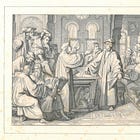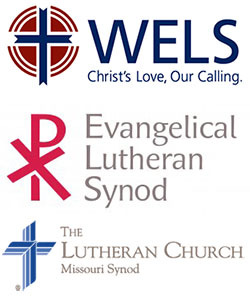Do Doctrines of Fellowship Have Any Meaning Today?
What is the point of a doctrine of fellowship if a church body has lost its internal doctrinal coherence?
As the LCMS’s Wyoming District ponders the issue of unionism and syncretism (see below), it’s worth stepping back to ask if a church body should be concerned with external fellowship concerns if its internal fellowship is chaotic.
History lessons
Maintaining doctrinal unity has been a persistent drama for Lutherans, not least in America. Indeed, the LCMS owes its existence to cumulative rejections of the General Synod’s (1820) incremental apostatization.1.
A later attempt at unity by a federation of Confessional Lutheran church bodies, the Synodical Conference (1872) insisted that the utmost confessional unity and exclusivity were essential for practicing church fellowship (pulpit sharing, altar communion, and joint prayer among different church bodies). However, not even a century later, the Synodical Conference imploded when the Evangelical Lutheran Synod (ELS) and Wisconsin Evangelical Synod (WELS) quit, having already severed fellowship with the LCMS some years earlier because Missouri was playing footsie with liberal church bodies2 and was ripening its concept of “levels of fellowship.”
A decade after breaking fellowship with the LCMS, the ELS and WELS seemed like prophets as Missouri became engulfed in the realization that its flagship seminary was not especially fond of the Bible or, therefore, God.3 The predicted “wave of indifferentism and unionism” had swamped Missouri via “rationalism, neo-orthodoxy, existentialism, liberalism, and humanism.” The aftershocks continue to be felt and observed, most chronically in the Synod’s demographic crisis and most acutely in episodic public unionism and syncretism, such as the 9/11 “Prayer for America”, Newtown vigil, and Bill Woolsey’s Katy, TX church covering AC/DC’s Highway to Hell4 for worship warmup (link to footnote 4 for the video).
Firstly, a church body once dedicated to the principles of God’s Word does not deteriorate or degenerate overnight. It is a slow and gradual process. So often, the crack in the dike seems so minute and insignificant that it seems ridiculous to worry about it. But, if that seemingly harmless crack is not recemented quite soon, it gradually grows wider and wider until the point comes when it cannot be repaired—a new one has to be constructed.
Rev. J.N. Petersen, 1972 ELS Synod Convention Essay
As early as 1936, the ELS warned Missouri5 that it was betraying biblical truth and compromising the gospel by pursuing church fellowship with other bodies despite the absence of prior evidence of doctrinal unity, which is the definition of unionism.
Whence our current divisions?
What the LCMS, ELS, and WELS disagree over today is vague for the families and friendships ripped apart by the fracture. At this point, it seems we have mostly agreed to be disagreeable over picayune matters relative to actual issues drowning Confessional Lutheran unity and identity6.
[If] the borders of the church cannot be defined and this means: even the border between church and heresy, truth and error disappears.
Hermann Sasse, "Confessional Churches In The Ecumenical Movement" The Springfielder, XXXI:1 (Spring, 1967), 9
The WELS did not heed its own admonitions, and there is no shortage of doctrinal chaos and disunity to be observed within and between its congregations today; only mildly less than in the LCMS. A glaring problem for the WELS was embracing the NIV 2011 translation with its gender neutrality7. The ELS rejects using the NIV, so where is the “utmost confessional unity” that warrants maintaining fellowship with the WELS? Likewise, it is puzzling that the ELS can remain in fellowship with the WELS despite the latter’s extreme liturgical “variety”, compromising its stated position on female authority, woke coziness8, etc. The ELS can boast a stronger confessional unity and liturgical uniformity than the LCMS and WELS, but even it has suffered some creep that sullies its claims to purity.
Don’t take that as a desire for the ELS and WELS to file for divorce. Instead, it’s simply to note that the “true Lutheranism” those Synods once espoused, and went to war with Missouri over, also no longer exists.
The indoor fellowship voice
For doctrines of fellowship to have any meaning or application, a Lutheran church body must have internal confessional unity with consonant liturgical forms. We can’t nag other Synods or adjacent civic institutions in good faith when we haven’t managed our own households well. Absent our houses being well ordered and united by and in pure doctrine, a Synodical doctrine of fellowship is rank hypocrisy, and our measure is smaller than a thimble: Luke 6:38.
Wyoming cannot be faulted for its desire for pure doctrine and clear boundaries to better deal with our neighbors in other estates or those in mixed or false confessions. However, it underscores the extent of LCMS disunity when you compare Wyoming’s commendable internal confessional unity and liturgical consistency9 with the happenings in other districts. We are a house divided and then subdivided; we have been warned repeatedly about our futile theological tampering:
The cry for new confessions is going through the Protestant world, including Lutheranism. This will lead Lutheranism into the situation which we find on the Anglican and Reformed mission fields: The confession of the Lutheran Church which once bound together not only the Lutherans of a certain time, but also the Church of today with the Fathers and with the true confessors until the end of the world, will disintegrate in the Lutheran world just as it has disintegrated in the Anglican and in the majority of the Reformed churches. The Augsburg Confession, altered by every one according to his pleasure, will cease to be a confession. It will remain a historical monument of a deceased Church, a reminder of a great "tradition" which has had its time. The Lutheran Church will perish, swallowed by the vast ecumenical church of the future.
Hermann Sasse, "Confessional Churches In The Ecumenical Movement" The Springfielder, XXXI:1 (Spring, 1967), 28
☩TW☩
And a lot of fractiousness before and after that. See the American Lutheran Family Tree.
The United Lutheran Church of America (ULCA) and the American Lutheran Church (ALC).
“Modern Protestantism no longer understands the doctrine of the Reformation of the clarity and sufficiency of Holy Scripture because it no longer believes in its inspiration.” Hermann Sasse, "Confessional Churches In The Ecumenical Movement" The Springfielder, XXXI:1 (Spring, 1967), 31
[Verse 1]
Livin' easy, lovin' free
Season ticket on a one-way ride
Askin' nothin', leave me be
Takin' everything in my stride
Don't need reason, don't need rhyme
Ain't nothin' I'd rather do
Goin' down, party time
My friends are gonna be there too, yeah
[Chorus]
I'm on the highway to Hell
On the highway to Hell
Highway to Hell
I'm on the highway to Hell
[Verse 2]
No stop signs, speed limit
Nobody's gonna slow me down
Like a wheel, gonna spin it
Nobody's gonna mess me around
Hey, Satan, payin' my dues
Playin' in a rockin' band
Hey, mama, look at me
I'm on the way to the promised land, wow
[Chorus]
[Bridge]
Mmm
Don't stop me
Hey, hey, ooh
[Guitar Solo]
[Chorus]
[Outro]
And I'm goin' down
All the way, woah!
I'm on the highway to Hell
Who can’t appreciate this foreword from the ELS document:
Two years ago the following words were addressed to our annual convention. “The Melanchtonian spirit of synergism, compromise, and unionism all but succeeded in preventing the giving of the Augsburg Confession to the World. After Luther’s death the same spirit raised its head again and made protracted and insidious attacks on Scripture truth as confessed at Augsburg. This time it brought forth an Altered Augsburg Confession. It has been active ever since, though its voice has at times been somewhat muted and its operations varying in degree of boldness.
“The forces thus set in motion within the early Lutheran Church, and which have their deep-set roots in natural man’s reason and inclination, are today bringing forth a bountiful harvest of indifferentism to, and misuse of, God’s Word, of compromise and of related sins. Throughout the length and breadth of our land a strong, influential voice is now reverberating, bearing the message. ‘God’s Moment is Now’ for ‘recognition and fellowship’ among American Lutherans. Voices are also lifted in the interest of the ‘whole problem of American Church Unity’ which express the hope that ‘the tide toward a true, free national church in America’ may set in.
“The wave of indifferentism and unionism that threatened to swamp us, and that did wash overboard many of our friends and brethren two decades ago, was relatively small and timid as compared to the great and bold wave now advancing on orthodox Lutheranism in America and the world. The prevailing winds are against us, the tides and currents are contrary, the sea is rough. Brethren, the need of the hour is faithful — I repeat, faithful, fearless, consecrated captains with firm hands to the helm, eyes fixed on the compass and chart-the open Bible-and a vigorous ‘get thee hence, Satan’ to every suggestion of reason, convenience, and self-aggrandizement.”
Since then the wave has continued to advance and has increased in boldness. Realizing the imminent danger, and awake to their responsibilities as watchmen, our pastors are sounding the warning.
“The main differences are in the categories of church and ministry, the application of fellowship principles, and the roles of men and women.” ‘Differences between WELS and LCMS’.
In fairness, WELS has become more relaxed about Bible translations, allowing congregations to “examine and utilize other translations like the ESV, the Christian Standard Bible, and the Evangelical Heritage Version.” Northwest Publishing House offers three versions of Luther’s Catechism using the ESV, NIV [2011 gender neutral…], or EHV.
See also:
Wyoming’s harmony and self-discipline are surely inseparable from the work product of its District President, Rev. Dr. John Hill. This is his reported workload for calendar years 2021–2024:
277 meetings or visits with congregations
1,800+ visits/conversations with individuals (district and Synod)
186 times preaching
41 times teaching Bible Class or confirmation class
41 formal presentations in congregations, circuits, District, Synod
21 formal congregation visitations
3 ordinations
17 installations of pastors. 16 of our 60 congregations received a new pastor!
15 Circuit Pastors Conferences (Winkels)
7 District Pastor/Teacher conferences
130 District meetings over 139 days (Board of Directors—5 annually; Circuit
Visitors—2 annually; Praesidium—5 annually; Commission meetings; etc.)
46 Synod meetings; 160 days of meeting and travel (Council of Presidents, Synod Convention, other)
94 Luther Classical College meetings, involving parts or all of 107 days
19 continuing education events over 64 days





